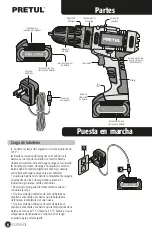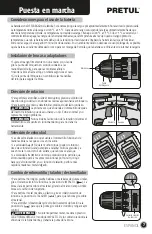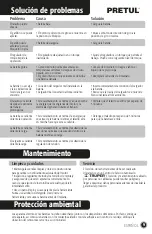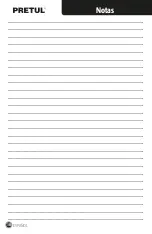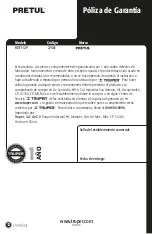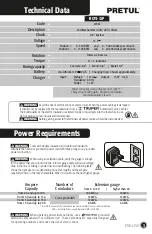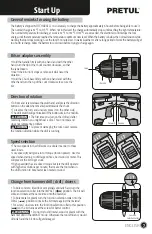
8
Start Up
ENGLISH
Torque
regulator
• To select the desired torque level to screw drive, turn the torque
regulator until it matches the corresponding number with the upper mark:
From 1 to 3 for small screws,
From 4 to 7 for screws on soft materials,
From 8 to 11 for screws on soft and hard material.
From 12 to 15 for screws on hard wood,
On 16 to 21, for larger screws.
• The torque level necessary depends on the type of
screw to be used and the material onto which you are working. If in
doubt use a lower torque and increase gradually until reaching the right
one. An adequate torque prevents damaging the tool.
Torque Adjust
CAUTION
LED light is ON while
the switch is pushed
and is OFF when
releasing the switch.
Turn On and operation control
• The switch allows selecting the adequate speed for each
job. The more you push the switch the fastest the drill will
run.
• The switch is also built with a braking function. When
releasing the trigger, the drill will immediately stop and you
will be able to use it as a manual screwdriver to give a screw
an extra turn.
Screwing - Unscrewing
• It is recommended to first bore a “pilot orifice”; slightly
longer and barely narrower than the measurements of the
screw. This orifice will be the entry guide for the screw and
will make it easier to tighten. When screwing near the edge
of a work piece, a pilot orifice prevents the wood from
cracking.
• Use the adequate type of tip for each screw head to
prevent the screw from sticking over from the surface.
• If inserting the screw gets difficult, remove and try to
bore a slightly longer or wider orifice. However keep in
mind there should be enough material to fasten the screw.
If you reinitiate the screwing operation in an already-made
orifice, start threading it by hand. If still difficult to thread
the screw (as with noble woods), try using lubricants like
soap. Liquid soap is more useful.
• Always apply enough pressure on the drill to prevent the
screw head to slide. It is easy that the screw head gets
damaged, making it difficult to completely get inserted or
even to remove it.
Additional recommendations
• Use the adequate speed for each job: do not try to bore at low speeds or to screw at high speeds.
• If the operation overloads the drill, take it out and repeat the operation applying less strength.
• Use low speeds to start bores where there is no support point; on plastic or metal; when screwing, boring ceramic or any
other application that requires a high torque. Use high speeds to drill woods and using polishing devices.
• To get a longer drill duty life, use the variable speed control.
Drilling
• When trying to bore large diameter orifices it is better to
start with a narrow bit and then replace it with the required
size. This prevents overloading the drill.
• When drilling deep orifices remove the bit a little and
regularly while boring to allow the shavings to be correctly
expelled from the orifice.
• If the bit gets stuck, immediately release
the switch to prevent damaging the tool. Try to release the
bit reversing the operation direction.
• Keep the drill aligned regarding the orifice. Ideally the bit
shall enter the work piece perpendicularly. If the angle is
changed while drilling, it could make the bit to break and
block the orifice or causing personal injury.
CAUTION
Summary of Contents for 27081
Page 10: ...10 ESPAÑOL Notas ...
Page 22: ...10 ENGLISH Notes ...

